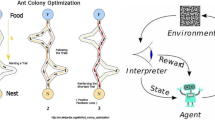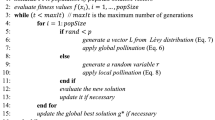Abstract
In this paper, we propose a new optimal framework with repair strategy to resolve major issues in the assignment of resources to mobile terminals (plainly to users) in WCDMA networks. The main goal of this proposed approach is to tackle the issues in the assignment of resources such as (1) load factor, (2) total capacity, (3) power, (4) channelization codes and (5) user’s not including any of the service. Our proposed RA-OABC approach adopts the repair strategy for the replacement of resource which violates the weight factor condition (i.e. Φ ≤ 1). The resource replacement is practiced just by removing the unfeasible resource and substituting it with new feasible resource (repaired versions). The oppositional artificial bee colony (OABC) algorithm acts well on the groups (assignment of users to the base stations) in a very efficient manner. Moreover, our proposed approach also exhibits a superior performance than that of the conventional technique by means of users receiving the requested services with increased availability of resources. The experimental study for the proposed RA-OABC approach is effectively carried out on various scenarios: the different number of users, user’s profiles, effects on the distributions of different number of user’s and so on.














Similar content being viewed by others
References
Toskala, A., Holma, H., & Muszynski, P. (1998). ETSI WCDMA for UMTS. In 1998 IEEE 5th international symposium on spread spectrum techniques and applications (Vol. 2, pp. 616–620). IEEE.
Shah, S. I. (2008). Umts: High speed packet access (hspa) technology. In Networking and communications conference, INCC 2008. IEEE international (pp. 2–2). IEEE.
Van Audenhove, L., Ballon, P., Poel, M., & Staelens, T. (2007). Government policy and wireless city networks: A comparative analysis of motivations, goals, services and their relation to network structure. The African Journal of Information and Communication, 8(2007), 108–135.
Wacker, A., & Laiho, J. (2001). Mutual impact of two operators’ WCDMA radio networks on coverage, capacity and QoS in a macro cellular environment. In Vehicular technology conference, IEEE VTS 54th (Vol. 4, pp. 2077–2081). IEEE.
Perez-Romero J., Sallent, O., Agusti, R., Karlsson, P., Barbaresi, A., Wang, L., Casadevall, F., et al. (2005). Common radio resource management: Functional models and implementation requirements. In 2005. PIMRC 2005. IEEE 16th international symposium on personal, indoor and mobile radio communications (Vol. 3, pp. 2067–2071). IEEE.
Bettstetter, C. (2003). Mobility modeling in wireless networks: Categorization, smooth movement, and border effects. ACM SIGMOBILE Mobile Computing and Communications, 5(3), 55–66.
Staehle, D., & Mäder, A. (2003). An analytic approximation of the uplink capacity in a UMTS network with heterogeneous traffic. In Teletraffic science and engineering (Vol. 5, pp. 81–90). Elsevier.
Kim, B. W., Park, J., & Ko, C. Y. (2013). Cost allocation of WCDMA and wholesale pricing for mVoIP and data services. Telecommunications Policy, 37(1), 35–47.
Okumura-Hata, Belhadj, N., Oueslati, B., & Aguili, T. (2015). Adjustment of cost Walfisch-I kegami model for HSPA + in Tunisian urban environments. In 2015, management on web applications and networking (WSWAN) (pp. 1–6). IEEE.
Cuadra, L., Salcedo-Sanz, S., Carnicer, A. D., Del Arco, M. A., & Portilla-Figueras, J. A. (2015). A novel grouping genetic algorithm for assigning resources to users in WCDMA networks. In A. Mora & G. Squillero (Eds.), Applications of evolutionary computation. EvoApplications 2015. Lecture Notes in Computer Science (Vol. 9028, pp. 42–53). Cham: Springer.
James, T., Vroblefski, M., & Nottingham, Q. (2007). A hybrid grouping genetic algorithm for the registration area planning problem. Journal on Computer Communication, 30(10), 2180–2190.
Agustí n-Blas, L. E., Salcedo-Sanz, S., Vidales, P., Urueta, G., & Portilla-Figueras, J. A. (2011). Near optimal citywide WiFi network deployment using a hybrid grouping genetic algorithm. Expert System Application, 38(8), 9543–9556.
Tan, C. K., Chuah, T. C., Tan, S. W., & Sim, M. L. (2012). Efficient clustering scheme for OFDMA-based multicast wireless systems using grouping genetic algorithm. Electronics Letters, 48(3), 184–186.
Chao, C.-M. (2008). OVSF code assignment strategies with minimal fragmentations for WCDMA systems. Journal on Computer Networks, 52(12), 2331–2343.
Metlicka, M., & Davendra, D. (2016). Complex network based adaptive artificial bee colony algorithm. In 2016 IEEE congress on evolutionary computation (CEC) (pp. 3324–3331). IEEE.
Aydin, M. E., Kwan, R., Leung, C., Maple, C., & Zhang, J. (2013). A hybrid swarm intelligence algorithm for multiuser scheduling in HSDPA. Applied Soft Computing, 13(5), 2990–2996.
Goransson, B., Cairns, D., Wang, Y.-P. E., Cozzo, C., Fulghum, T., & Grant, S. (2007). Evolution of WCDMA high speed packet access and broadcast services. In 2007. IEEE 8th workshop on signal processing advances in wireless communications (pp. 1–5). IEEE.
Sundararaj, V., Muthukumar, S., & Kumar, R. S. (2018). An optimal cluster formation based energy efficient dynamic scheduling hybrid MAC protocol for heavy traffic load in wireless sensor networks. Computers & Security, 77, 277–288.
Karaboga, D., & Gorkemli, B. (2014). A quick artificial bee colony (qABC) algorithm and its performance on optimization problems. Applied Soft Computing, 23, 227–238.
Agarwal, S. K., & Sahu, O. P. (2015). Artificial bee colony algorithm to design two-channel quadrature mirror filter banks. Swarm and Evolutionary Computation, 21, 24–31.
Rahnamayan, S., Tizhoosh, H. R., & Salama, M. A. (2008). Opposition based differential evolution. IEEE Transactions on Evolutionary Computation, 12(1), 64–79.
Dosaranian-Moghadam, M., Bakhshi, H., Dadashzadeh, G., Godarzvand-Chegini, M. (2010). Joint base station assignment, power control error, and adaptive beam forming for DS-CDMA cellular systems in multipath fading channels. In Mobile congress (GMC), 2010 Global (pp. 1–7). IEEE.
Dartmann, G., Afzal, W., Gong, X., & Ascheid, G. (2011). Joint optimization of beam forming, user scheduling, and multiple base station assignment in a multi cell network. In Wireless communications and networking conference (WCNC), 2011 IEEE (pp. 209–214). IEEE.
Zhang, C., Chen, J., & Xin, B. (2013). Distributed memetic differential evolution with the energy of Lamarckian and Baldwinian learning. Applied Soft Computing, 13(5), 2947–2959.
Olmos, J. J., Ferrus, R., & Galeana-Zapién, H. (2013). Analytical modeling and performance evaluation of cell selection algorithms for mobile networks with backhaul capacity constraints. IEEE Transaction on Wireless Communication, 12(12), 6011–6023.
Galeana-Zapién, H., & Ferrús, R. (2010). Design and evaluation of a backhaul-aware base station assignment algorithm for OFDMA-based cellular networks. IEEE Transaction on Wireless Communication, 9(10), 3226–3237.
Liu, H.-L., Gu, F., Cheung, Y.-M., Xie, S., & Zhang, J. (2014). On solving WCDMA network planning using iterative power control scheme and evolutionary multi objective algorithm. IEEE Computational Intelligence Magazine, 9(1), 44–52.
Zhu, S. F., Liu, F., Qi, Y. T., Chai, Z. Y., & Wu, J. S. (2012). Immune optimization algorithm for solving joint call admission control problem in next-generation wireless network. Engineering Applications of Artificial Intelligence, 25(7), 1395–1402.
Karaboga, D., & Akay, B. (2011). A modified artificial bee colony (ABC) algorithm for constrained optimization problems. Applied Soft Computing, 11, 3021–3031.
Mirjalili, S., Mirjalili, S. M., & Lewis, A. (2014). Grey wolf optimizer. Advances in Engineering Software, 69, 46–61.
Chiang, C.-L. (2005). Improved genetic algorithm for power economic dispatch of units with valve-point effects and multiple fuels. IEEE Transactions on Power Systems, 20(4), 1690–1699.
Tizhoosh, H. (2005). Opposition-based learning: A new scheme for machine intelligence. In Proceedings of international conference on computational intelligence for modelling, control and automation, CIMCA (pp. 695–701).
Author information
Authors and Affiliations
Corresponding author
Additional information
Publisher's Note
Springer Nature remains neutral with regard to jurisdictional claims in published maps and institutional affiliations.
Rights and permissions
About this article
Cite this article
Safikul Alam S, Chandra, S. & Bhattacharya, S. RA-OABC: An Optimal Framework for Resource Assignment in WCDMA Networks Using Oppositional Artificial Bee Colony Algorithm with Repair Strategies. Wireless Pers Commun 103, 1535–1562 (2018). https://doi.org/10.1007/s11277-018-5867-2
Published:
Issue Date:
DOI: https://doi.org/10.1007/s11277-018-5867-2




